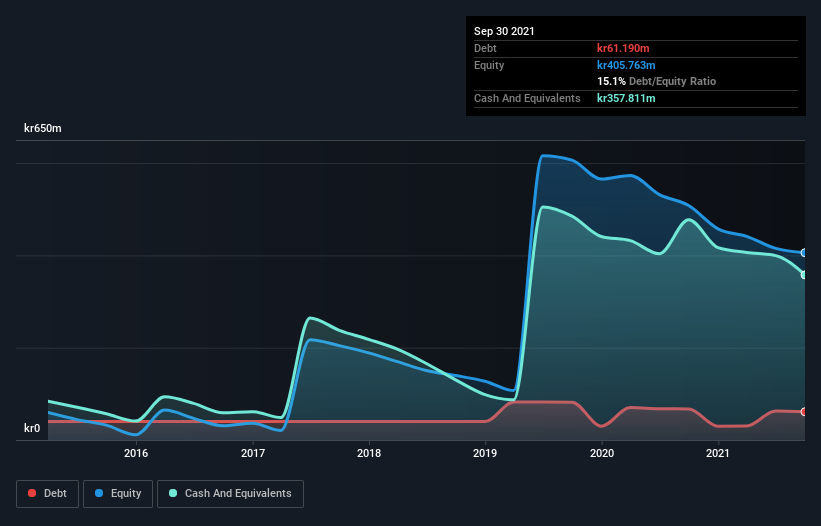
The external fund manager backed by Berkshire Hathaway's Charlie Munger, Li Lu, makes no bones about it when he says 'The biggest investment risk is not the volatility of prices, but whether you will suffer a permanent loss of capital.' When we think about how risky a company is, we always like to look at its use of debt, since debt overload can lead to ruin. We note that PowerCell Sweden AB (publ) (STO:PCELL) does have debt on its balance sheet. But the more important question is: how much risk is that debt creating?
Why Does Debt Bring Risk?
Generally speaking, debt only becomes a real problem when a company can't easily pay it off, either by raising capital or with its own cash flow. Ultimately, if the company can't fulfill its legal obligations to repay debt, shareholders could walk away with nothing. However, a more common (but still painful) scenario is that it has to raise new equity capital at a low price, thus permanently diluting shareholders. Of course, debt can be an important tool in businesses, particularly capital heavy businesses. When we think about a company's use of debt, we first look at cash and debt together.
View our latest analysis for PowerCell Sweden
What Is PowerCell Sweden's Net Debt?
The image below, which you can click on for greater detail, shows that PowerCell Sweden had debt of kr61.2m at the end of September 2021, a reduction from kr67.3m over a year. However, its balance sheet shows it holds kr357.8m in cash, so it actually has kr296.6m net cash.

How Healthy Is PowerCell Sweden's Balance Sheet?
The latest balance sheet data shows that PowerCell Sweden had liabilities of kr72.3m due within a year, and liabilities of kr61.2m falling due after that. Offsetting these obligations, it had cash of kr357.8m as well as receivables valued at kr64.6m due within 12 months. So it actually has kr288.9m more liquid assets than total liabilities.
This short term liquidity is a sign that PowerCell Sweden could probably pay off its debt with ease, as its balance sheet is far from stretched. Simply put, the fact that PowerCell Sweden has more cash than debt is arguably a good indication that it can manage its debt safely. The balance sheet is clearly the area to focus on when you are analysing debt. But ultimately the future profitability of the business will decide if PowerCell Sweden can strengthen its balance sheet over time. So if you want to see what the professionals think, you might find this free report on analyst profit forecasts to be interesting.
Over 12 months, PowerCell Sweden reported revenue of kr141m, which is a gain of 53%, although it did not report any earnings before interest and tax. Shareholders probably have their fingers crossed that it can grow its way to profits.
So How Risky Is PowerCell Sweden?
Statistically speaking companies that lose money are riskier than those that make money. And the fact is that over the last twelve months PowerCell Sweden lost money at the earnings before interest and tax (EBIT) line. And over the same period it saw negative free cash outflow of kr98m and booked a kr102m accounting loss. With only kr296.6m on the balance sheet, it would appear that its going to need to raise capital again soon. PowerCell Sweden's revenue growth shone bright over the last year, so it may well be in a position to turn a profit in due course. By investing before those profits, shareholders take on more risk in the hope of bigger rewards. When analysing debt levels, the balance sheet is the obvious place to start. But ultimately, every company can contain risks that exist outside of the balance sheet. For example - PowerCell Sweden has 1 warning sign we think you should be aware of.
If, after all that, you're more interested in a fast growing company with a rock-solid balance sheet, then check out our list of net cash growth stocks without delay.
New: Manage All Your Stock Portfolios in One Place
We've created the ultimate portfolio companion for stock investors, and it's free.
• Connect an unlimited number of Portfolios and see your total in one currency
• Be alerted to new Warning Signs or Risks via email or mobile
• Track the Fair Value of your stocks
Have feedback on this article? Concerned about the content? Get in touch with us directly. Alternatively, email editorial-team (at) simplywallst.com.
This article by Simply Wall St is general in nature. We provide commentary based on historical data and analyst forecasts only using an unbiased methodology and our articles are not intended to be financial advice. It does not constitute a recommendation to buy or sell any stock, and does not take account of your objectives, or your financial situation. We aim to bring you long-term focused analysis driven by fundamental data. Note that our analysis may not factor in the latest price-sensitive company announcements or qualitative material. Simply Wall St has no position in any stocks mentioned.
About OM:PCELL
PowerCell Sweden
Develops and produces fuel cells and fuel cell systems for automotive, marine, and stationary applications in Sweden and internationally.
Flawless balance sheet with limited growth.

